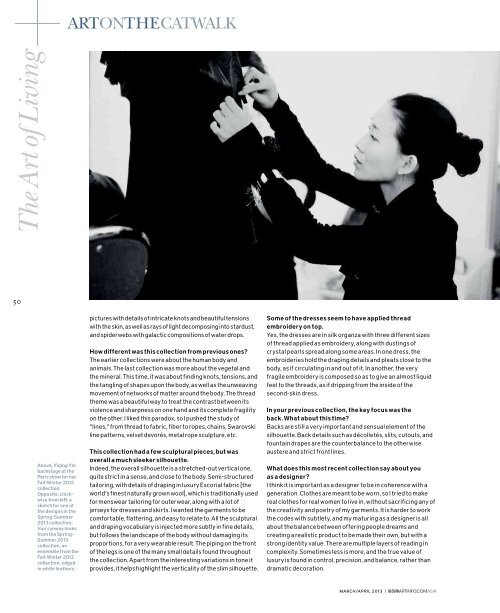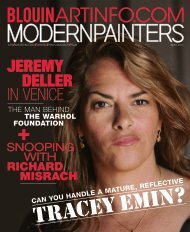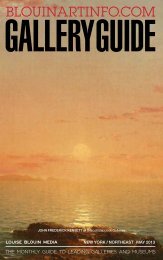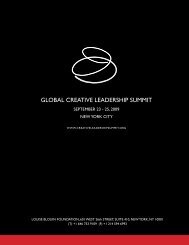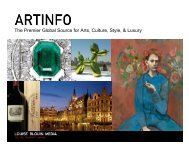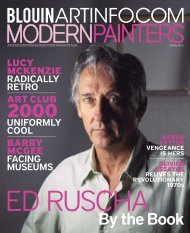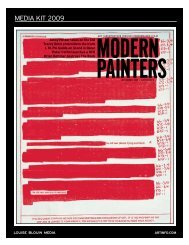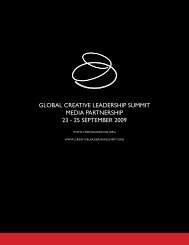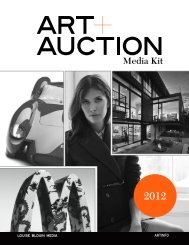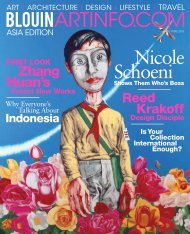Linke - Artinfo
Linke - Artinfo
Linke - Artinfo
Create successful ePaper yourself
Turn your PDF publications into a flip-book with our unique Google optimized e-Paper software.
The Art of Living<br />
50<br />
Above, Yiqing Yin<br />
backstage at the<br />
Paris show for her<br />
Fall-Winter 2012<br />
collection.<br />
Opposite, clockwise<br />
from left: a<br />
sketch for one of<br />
the designs in the<br />
Spring-Summer<br />
2013 collection;<br />
four runway looks<br />
from the Spring-<br />
Summer 2013<br />
collection; an<br />
ensemble from the<br />
Fall-Winter 2012<br />
collection, edged<br />
in white feathers.<br />
ARToNThecATwAlk<br />
pictures with details of intricate knots and beautiful tensions<br />
with the skin, as well as rays of light decomposing into stardust,<br />
and spiderwebs with galactic compositions of water drops.<br />
How different was this collection from previous ones?<br />
The earlier collections were about the human body and<br />
animals. The last collection was more about the vegetal and<br />
the mineral. This time, it was about finding knots, tensions, and<br />
the tangling of shapes upon the body, as well as the unweaving<br />
movement of networks of matter around the body. The thread<br />
theme was a beautiful way to treat the contrast between its<br />
violence and sharpness on one hand and its complete fragility<br />
on the other. I liked this paradox, so I pushed the study of<br />
“lines,” from thread to fabric, fiber to ropes, chains, Swarovski<br />
line patterns, velvet devorés, metal rope sculpture, etc.<br />
This collection had a few sculptural pieces, but was<br />
overall a much sleeker silhouette.<br />
Indeed, the overall silhouette is a stretched-out vertical one,<br />
quite strict in a sense, and close to the body. Semi-structured<br />
tailoring, with details of draping in luxury Escorial fabric [the<br />
world’s finest naturally grown wool], which is traditionally used<br />
for menswear tailoring for outerwear, along with a lot of<br />
jerseys for dresses and skirts. I wanted the garments to be<br />
comfortable, flattering, and easy to relate to. All the sculptural<br />
and draping vocabulary is injected more subtly in fine details,<br />
but follows the landscape of the body without damaging its<br />
proportions, for a very wearable result. The piping on the front<br />
of the legs is one of the many small details found throughout<br />
the collection. Apart from the interesting variations in tone it<br />
provides, it helps highlight the verticality of the slim silhouette.<br />
Some of the dresses seem to have applied thread<br />
embroidery on top.<br />
Yes, the dresses are in silk organza with three different sizes<br />
of thread applied as embroidery, along with dustings of<br />
crystal pearls spread along some areas. In one dress, the<br />
embroideries hold the draping details and pleats close to the<br />
body, as if circulating in and out of it. In another, the very<br />
fragile embroidery is composed so as to give an almost liquid<br />
feel to the threads, as if dripping from the inside of the<br />
second-skin dress.<br />
In your previous collection, the key focus was the<br />
back. What about this time?<br />
Backs are still a very important and sensual element of the<br />
silhouette. Back details such as décolletés, slits, cutouts, and<br />
fountain drapes are the counterbalance to the otherwise<br />
austere and strict front lines.<br />
What does this most recent collection say about you<br />
as a designer?<br />
I think it is important as a designer to be in coherence with a<br />
generation. Clothes are meant to be worn, so I tried to make<br />
real clothes for real women to live in, without sacrificing any of<br />
the creativity and poetry of my garments. It is harder to work<br />
the codes with subtlety, and my maturing as a designer is all<br />
about the balance between offering people dreams and<br />
creating a realistic product to be made their own, but with a<br />
strong identity value. There are multiple layers of reading in<br />
complexity. Sometimes less is more, and the true value of<br />
luxury is found in control, precision, and balance, rather than<br />
dramatic decoration.<br />
MARCH/APRIL 2013 | Blouin<strong>Artinfo</strong>.comAsiA<br />
CLOCKWISE FROM LEFT: YIQING YIN; FIVE IMAGES, SHOJI FUJII AND YIQING YIN.<br />
OPPOSITE: JONATHAN P. LEVY AND YIQING YIN.<br />
You sketch but also use swatches of fabrics to build the<br />
garment on your mannequin. It’s a very sculptural approach.<br />
It is. It’s a very instinctive and sensitive approach. I draw a<br />
rough-proportion sketch to note the idea, but most of the<br />
design I find while sculpting directly on the mannequin. So the<br />
creative process happens directly, with the draping action.<br />
Is draping part of your signature design?<br />
I think so. Draping is a way to construct garments; it’s a very<br />
traditional construction method, as opposed to flat<br />
patterning. I do most of my designs by draping, in volume, in<br />
three dimensions. But I also think that by de-structuring and<br />
changing the traditional method of draping, I’ve found<br />
interesting new elements, shapes, and volumes. Pleating is<br />
also recurrent in my work, because I think it’s quite an<br />
interesting technique, with a lot of potential to develop<br />
from a flat surface into a multifaceted, three-dimensional<br />
garment. Pleating gives dynamics to a flat surface.<br />
By contorting the fabric you can create something complex<br />
to the eye, which is also quite mathematical in a way.<br />
You launched a ready-to-wear collection in 2012. How do<br />
you approach that differently from couture?<br />
Ready-to-wear is about working the product—starting from an<br />
ideal but making it accessible for the customer. Couture does<br />
not have a meaning if, in the end, the ideal is not worn by a<br />
woman. I don’t want to be elitist. The couture pieces on the<br />
runway are more experimental, which allows me complete<br />
creative freedom with no restrictions. Couture is like a<br />
laboratory, and from those experiments we pick the strongest<br />
influences and translate them for ready-to-wear.<br />
Blouin<strong>Artinfo</strong>.comAsiA | MARCH/APRIL 2013<br />
85


